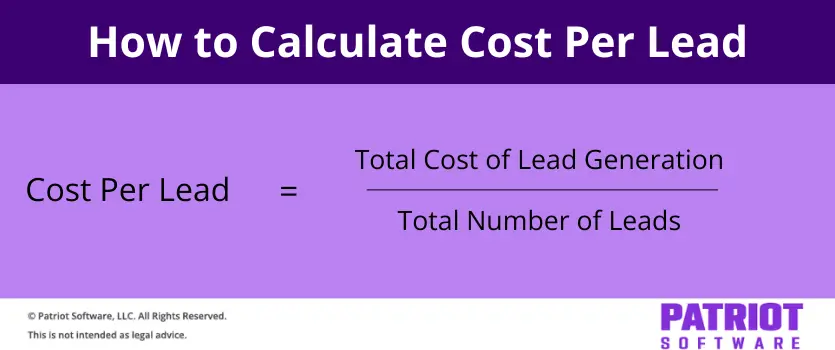You already know that leads are vital to your business’s future. And you can’t bring in quality leads without spending money on marketing. You’ve got to speculate to accumulate, right? But do you know how much it actually costs to generate a single lead?
Unless you understand your lead-gen spending, you can’t tell if your marketing and sales efforts are truly effective. This is where the cost per lead (CPL) calculation comes in.
In this post, we’ll explain the importance of CPL for maximizing business expenses, show you how to calculate it, and offer some tips on how to reduce it.
What is cost per lead?
Cost per lead (CPL) is a marketing metric that measures the total cost involved in generating a single lead for your business. It represents the dollar amount spent on attracting a potential customer who has shown interest in your product or service.
Depending on the type of marketing campaign, a quality lead could be someone who has:
- Visited your pricing page
- Filled in your contact form
- Downloaded your whitepaper
- Commented on your social media posts
Cost per lead is a good way of determining the success (or otherwise) of your digital marketing efforts. You can use it to evaluate specific campaigns on specific channels, or to gauge the efficiency of your overall marketing spend.
CPL should not be confused with cost per acquisition (CPA). CPA shows the total cost of acquiring a paying customer or closing a deal, while CPL is all about the cost of generating potential customers. (Leads are different from prospects: here’s some info about lead generation vs prospecting.)
Why is CPL important?
Marketing typically represents a significant chunk of overall business expenses, so it’s essential that you measure the effectiveness of your efforts and find ways to optimize spending. Cost per lead is a critical metric for tracking the performance of sales and marketing campaigns.
When you know how much it costs to generate each potential customer, you can allocate your marketing budget and your client management efforts more efficiently. You can compare channels and strategies to see which ones have the best ROI, and invest in those—while ditching the ones that aren’t cost-effective.
And if you pair CPL data with other marketing metrics, you can see if a particular campaign or channel is bringing in the wrong leads; people who are never likely to convert. Your CPL calculation can then help you course-correct, saving time and money.
Besides providing insights into your marketing efforts, CPL helps you to challenge assumptions. If a big campaign is getting a lot of attention and producing high-quality leads, it’s easy to assume it’s effective. But in reality, a low-key campaign with lower-quality leads may actually bring better ROI because your operational costs are lower.
What represents a “good” CPL?
This is kind of a trick question. There’s no official definition of a good (or bad, or average) CPL that applies across all businesses and industries.
That’s because cost per lead is based on various different factors, such as:
- Industry type
- Company size
- Marketing budget
- Target audience
- Channel mix
- Cost of your product or service
- Competitive landscape
- Economic climate
Highly-competitive or high-ticket industries, such as enterprise software or financial services, tend to have higher cost per lead. It’s the same for lead generation in B2B companies. The value of each lead is higher, sales cycles are longer and more complex, and the target markets are more specialized.
The cost of your product or service is also an important factor. For example, let’s say you have a CPL of $80. Would that count as good? Well, if your products sell for $20 each, then no. But if you’re offering something that sells for $2,000, a CPL of $80 looks pretty good.
What we’re saying is, you need to determine what represents a good or bad cost per lead for your business, taking all of the above into account. As a rule, a good CPL means that the figure is lower than the amount you’re expecting to make from an average lead.
A bad CPL would mean that the cost of generation is higher than the revenue expected from that same average lead (which would result in a net loss). What’s the expected revenue? Again, this varies by business. It depends on how much your average customer spends and your conversion rate.
You can also look at the average cost per lead in your industry or sector, and use that as a benchmark. Don’t forget that a higher conversion rate (when leads become customers) can justify a higher cost per lead, and factor in lead quality and potential lifetime value.
How to calculate cost per lead
As we’ve mentioned, leads do vary in value. You can gauge value by the level of interest in your offering, and whether the lead has the resources to become a longstanding customer. But lead value isn’t always apparent, so for the purposes of this calculation, you should treat all leads as roughly equal in terms of worth.
The other key factor is to choose a consistent time period for your calculations, such as a month, a quarter, or a year. If you don’t do this, you won’t be able to compare the results accurately.
So, how do you calculate cost per lead? You take the total amount you spent on a certain campaign, and divide it by the number of leads generated by that campaign.

Let’s look at a basic example. You spend $3,000 on an email marketing campaign, and it generates 200 leads. The calculation ($5,000 / 200) would give you a CPL of $15.
Calculating costs
The first thing to do is calculate your costs. These represent every investment relating to a marketing campaign, including advertisements, online content, and software tools. You’ll need to look at your marketing-related agency fees and labor costs, too.
Most businesses generate leads through a combination of paid advertising and attracting organic traffic to their website. In fact, you may want to run separate calculations to find the CPL for inbound and outbound marketing.
Paid ads typically cost more than organic strategies, which means a higher cost per lead. Organic traffic tends to bring lower CPLs, as leads build up over time through SEO and content marketing.
It can be helpful to break down your costs per month (or whatever time increment you’re using):
Costs Per Month = Advertising Costs + Inbound Costs
Then there’s the cost of the people required to manage your ad campaigns, who may be in-house employees or external staff in an agency employed by your business. We can call this ad management:
Advertising Costs = Ad Spend + Ad Management
Your inbound costs, meanwhile, cover things like landing page creation, content marketing via blogs or social media, and SEO efforts. Again, you may use internal resources or outsource the work to agencies and consultants.
Inbound Costs = External Resources + Internal Resources
Now, add all of these figures together to find the total cost of lead generation (per time period).
Calculating leads
You’ll need to find the total number of leads for both paid ads and inbound marketing.
Add up your total inbound leads (landing page visitors, social media followers, form submissions, referrals from blogs), and your total outbound leads (from paid advertising, whether digital or print):
Total Leads = Inbound Leads + Outbound Leads
Once you have all the figures in place, you can go ahead and perform the final CPL calculation:
Cost Per Lead = Total Cost of Lead Generation / Total Number of Leads
The good news is, you don’t need an accountant to perform this calculation. You can download the Cost Per Lead Calculator from Leadfeeder, or use platforms like Google Ads and Facebook to help you find the CPL of each campaign.
How to use cost per lead
Now that you know how to calculate CPL, you can put it to use and compare the cost-effectiveness of various marketing channels, and campaigns.
As well as the overall cost per lead for your business, you might calculate CPLs for the following:
- Overall CPL for outbound marketing efforts
- Overall CPL for inbound marketing efforts
- CPL for each individual marketing channel (email, web search, blogs, social media, Google Ads)
- CPL for specific marketing campaigns (product launch, sales promotion, event sign-up)
- CPL for different audience segments (demographic, geographic, psychographic)
With these figures, you can determine the most profitable methods and target groups. Make sure you monitor the CPLs over time, so that you can identify trends and opportunities. For example, if the cost per lead is flat or increasing, you may need to reevaluate your marketing efforts.
How to reduce cost per lead
Reducing your CPL will help you to maximize your business expenses and make your marketing budget stretch farther. The best way to do this is to adapt your strategies to bring in more qualified leads, thus reducing the cost of each one.
1. Consider business needs
Think about the size of your business and your place in the market. If you’re an enterprise with high revenue, you might be able to justify more ad spend overall, while higher spending can also be important if you’re facing lots of competition.
For smaller firms, it’s best to start off with a relatively small budget and pay close attention to campaign analytics to find the optimum time to expand.
2. Improve targeting
Improved audience targeting is a great way to increase the number of quality leads. You can also launch retargeting campaigns for people who didn’t convert at first, drawing them back in with relevant content and offers.
If your message isn’t reaching the right potential customers, adjust your segmentation and zone in on demographics or groups that have shown higher interest and higher conversion rates. Make sure to adjust your sales planning template to reflect these new segments.
3. Optimize your website
Greater online visibility will improve your organic reach and reduce your CPL. Boost search engine rankings by targeting long-tail keywords (used by searchers with serious intent), keep content fresh, and match the style and length of competing articles.
As well as improving navigation and page loading speed, refine your landing pages and make sure your lead magnets provide value. Add clarifying questions to sign-up forms to weed out less interested leads.
4. Use A/B testing
You can use A/B testing to see which variant of marketing material attracts more leads and therefore reduces CPL. For example, test elements of landing pages such as headings and CTAS, as well as different ad creatives.
It’s also a good idea to experiment with different channels to see which work best, and to ensure you’re not reliant on a single strategy. You can use testing to improve the timing of your ads and blog posts, finding the times when your target audience is active online.
5. Use the right tools
Swapping manual labor for automated tools will boost your lead generation efforts. Yes, you’ll need to spend some money on the software, but the efficiency will reduce your cost per lead in terms of human resources. Make sure your team is trained on how to make the most of it.
Consider specific lead generation software, accounting software to track expenses, automation for email and social media campaigns, and CRM systems to manage lead and customer information.
6. Track continuously
It’s important to calculate your CPLs on a regular basis, looking at performance across different marketing methods, channels, and campaigns. Remember, there are many factors that can affect cost per lead, such as economic climate and competitive landscape—and these can change rapidly.
You’ll need to evaluate CPL in the context of other sales and marketing metrics, including conversion rates, cost per acquisition, and ROI. You could also survey leads who converted after a campaign, using a CSAT score calculation, to help you gauge its success.
Final thoughts
Calculating your cost per lead is crucial for maximizing business expenses. Having this information makes it easier to identify any campaigns or channels that aren’t cost-effective and ensure your marketing budget is only spent on strategies with a high chance of success.
You’ll need to factor all advertising costs, both inbound and outbound, into your calculation. Decide what represents a good and bad CPL for your company, based on the factors we outlined earlier. Then, use the relevant tips to reduce cost per lead and streamline your marketing spend.
These views are made solely by the author.




